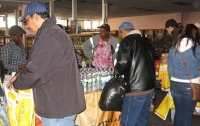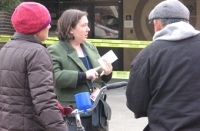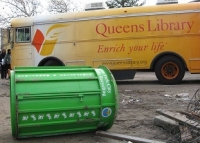Queens Library Response to Hurricane Sandy
Queens Library, N.Y.
Innovation Synopsis
Challenge/Opportunity
Hurricane Sandy caused mass destruction along Queens’ waterfront (“the Rockaways”) destroying homes, businesses and lives. Four libraries were destroyed. The community was physically cut off from the rest of the city. Power remained out for weeks. Schools were closed. Public transportation was inoperable. Fuel was not available for cars. Relief efforts did not seem to be gelling. Supply trucks could not deliver. The area was under a curfew, enforced by police and the National Guard. Without phones, TV, radio or internet, the residents had no way to know what was going on in the rest of the city. Residents were frightened, cold and miserable, cut-off, did not know what to do next, and lacking visible leadership.
Key Elements of Innovation
Although many library staff were affected by the storm, senior management stayed in contact to determine: what can we do to help the community right now, in the shortest possible time, and that we had the resources on hand to execute incurring no major purchasing issues. Immediately: Open buildings for warming shelters (even without power), put out power strips for charging, allow distribution of emergency supplies from the library buildings, even without power. By Sandy + 3 days: Mobile Library onsite with referral information. It required an OK from NYPD to enter the area. Library staff had 400 resource sheets re: shelters, food, benefits. Gone in 2 hours! Sandy +4 days: Far Rockaway Library manager opened the library as a relief center with no power. Default setting to all requests was YES. [can we accept a donation of food and water? Yes. Can NYCares distribute coats? Yes. Can a church group grill hot food in front of the library? Yes.] We needed to be highly visible, so the community knew we were there to support them in an active way. Mobile library bus had signage. Staff were out on the sidewalk, engaging the community. We concentrated on what libraries do best: reference and referrals, distributing authoritative information, being a free, trusted community space and staging area for other relief responses, and being a community hub. Recreation materials were important. We used the media to our advantage. Partnerships were critical in extending emergency services, borrowing generators, etc. because we already knew who to contact. The libraries stayed open 7 days a week, even holidays, for several weeks. Staff volunteered to be there.
Achieved Outcomes
The community flocked to the library to obtain emergency information, food, water, shelter, and to be together for consolation. 8,300 visitors used makeshift libraries in first week. By early December (Sandy + 5 weeks) makeshift libraries had 6,500 visitors a week. In the first weeks, the library distributed 9,000 donated meals, 6,000 coats, 1,500 blankets, thousands of packages of donated supplies. The community never stopped expressing appreciation for the library being a steady presence on the scene and showing leadership in the crisis. Two of the four libraries that were damaged will not re-open for a long time, but temporary buildings are serving the community during the rebuilding and have continued to be heavily used throughout. The library left an indelible impression on the residents. Their informational needs evolved from basic food and shelter to how to get emergency assistance, medical, employment and legal issues. Library services continue to evolve to meet needs. Lessons learned: Queens Library fosters a highly entrepreneurial culture of de-centralized decision-making. It values leaders at all levels of the organization. It is invaluable in a crisis, where you need people to step up and do what needs to be done. Pre-existing partnerships within the community are critical, with the police, healthcare providers, governmental agencies. We helped them, they helped the library, and we all helped the affected community. You can’t over-communicate. We kept elected officials, community, staff, the media informed every step of the way. Most important: never under-estimate your power to make a difference.



